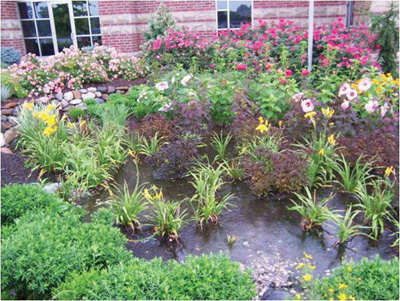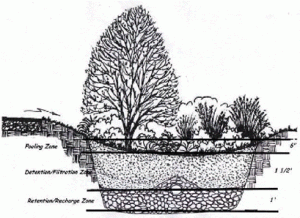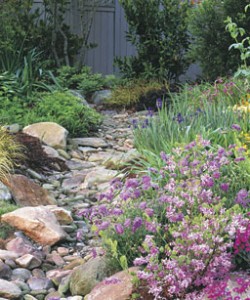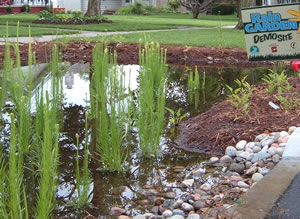
A rain garden! It sounds so Amazon-rainforest-like — puddly and misty and wet and cool. Doesn’t it sound lovely? A rain garden offers an attractive way to disguise an area that naturally floods and is normally not very pretty. It will also help prevent further soil erosion. Create your own rain garden on your property!
Rain gardens present a wonderful opportunity to collect all that rainwater that usually just slides away into the ground and use it to grow water-loving plants. Gardeners welcome the opportunity to “be green” so install your own rain garden and become greener! Rain water conservation is key in these times of limited water availability.

The day that I started to research and write this posting, it was raining cats and dogs outside! My Davis Weather Station collected over 1.5 inches of rain during the rain storm. We are about 5 inches behind last October’s rainfall rate here in my area of Virginia so any rain is welcome. I’ve created a few rain gardens in our backyard which certainly help disperse any standing water. Also, my rain gardens will collect and disperse water in an area that would normally flood — so I’ve also installed dry creek beds of gravel and decorative river rocks and smooth stones to help direct and soak up the water. See below for a view of the rain garden from the side and into the soil.

You’ll want to dig out an area (or fill in a deep gully) with a layer of large stones and then cover that with smaller gravel. Put at least a 6-inch layer of topsoil over the gravel for plantings. You can add some sand to the topsoil depending on your location, and whether or not you want plants that like sandy soil. Retain a bit of the natural slope so that the water will pool and then disperse. And get ready to plant!

Usually, landscaping architects will use a type of French drain to help dissapate the water between buildings or residential homes. The rain garden planted on top can help beautify the French drain area with lovely plantings instead of just a grassy area. In the past, I’ve been lucky enough to participate in the design and construction of a number of French drains. I only wish we’d been able to plant a rain garden above each!

A rain garden is meant to collect excess rainwater and then disperse it over a 6 – 12 hour period. You will need to select plants that do not mind wet soil that may stay damp and not completely dry out. Think about those trees and shrubs that live along rivers and streams.
Believe it or not, there are a lot of plants that can live in a wetter area than you would expect. Moisture tolerance for plants usually breaks into four areas — wet (soil waterlogged), moist (soil constantly moist), mesic (soil neither wet nor dry), or dry (soil is dry for long periods after a soaking/flooding rain).
Types of plants you can use based on your soil conditions are:
Wet: Aster, marsh marigold, iris, giant sunflower, some ferns, and Joe Pye weed.
Moist: Rudbeckia, phlox, creeping Jenny, beebalm, ferns, primrose, and goldenrod.
Mesic: Black-eyed Susan, foxglove, primula, loosestrife, and rudbeckia.
Dry: Butterfly weed, coneflower, aster, downy sunflower, and milkweed.
Trees you can use in your rain garden are:
Wet: Dogwood, alder, willow
Moist: Most birch trees, aspen, willow, swamp cypress,
Mesic: Maple, birch, sweet gum, serviceberry
Dry: Redbud, willow oak
Additionally, there are a number of lovely ornamental grasses that can be planted in a rain garden. Check the plant tag for information on the plant’s soil dampness tolerance prior to purchasing grasses in your area. Some grasses may multiply rapidly and some just stay in a clump.
My favorite book on this subject is: Rain Gardens: Managing Water Sustainably in the Garden and Designed Landscape by Nigel Dunnett and Andy Clayton. The above listings of plants and trees came from this book. Get it at Amazon:
Additionally, these books on rain gardening are useful:
Are you planning to install a rain garden? If so, let me know how it goes!

Leave a Reply
You must be logged in to post a comment.